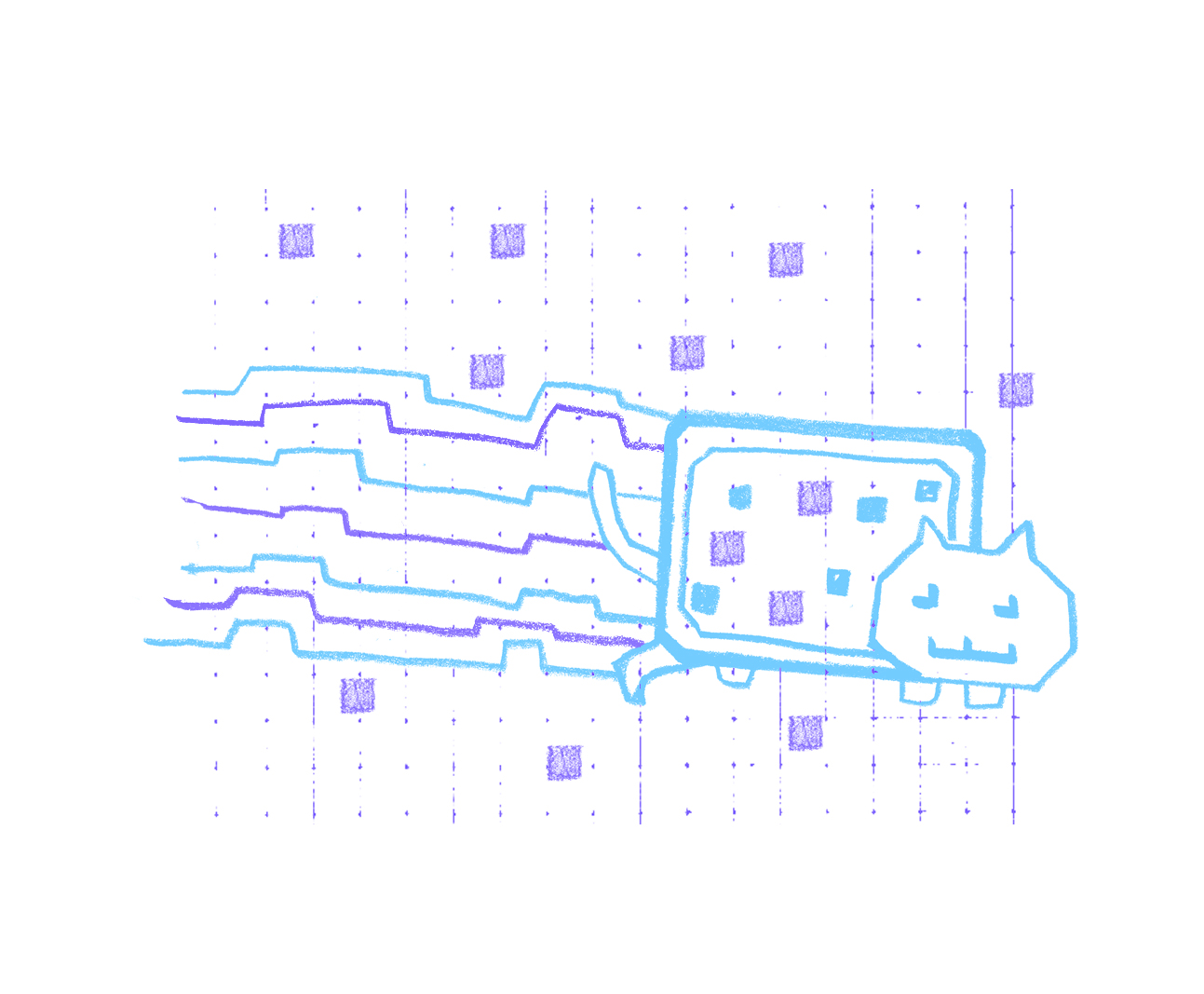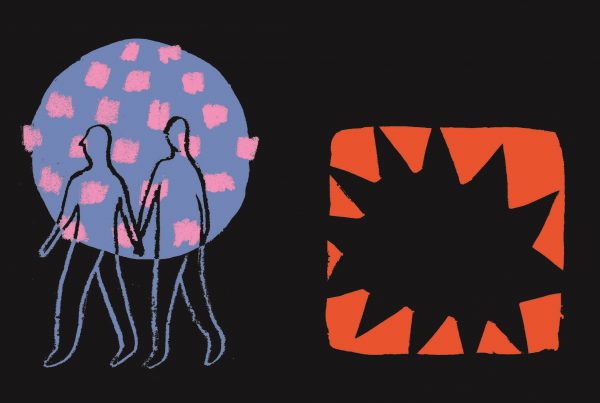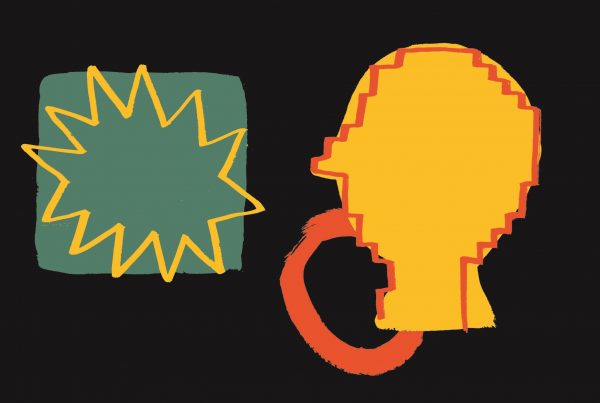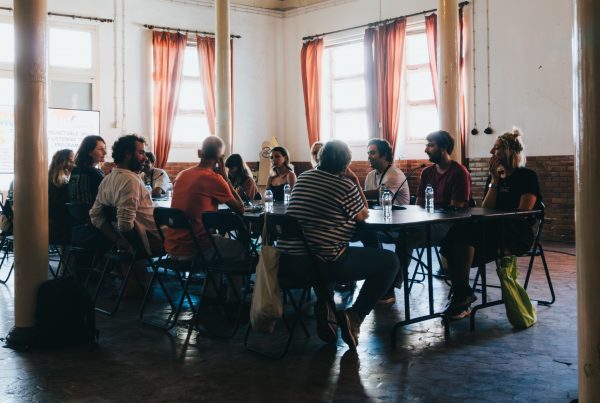Em Maio de 2014, o artista Kevin McCoy vendeu um GIF a Anil Dash na conferência Seven on Seven, organizada pela Rhizome, e cunhou a transferência de propriedade de um GIF na blockchain Namecoin. O registo na blockchain incluía uma ligação à licença, uma ligação à obra, um hash (um tipo de impressão digital) da obra e uma simples declaração de propriedade em inglês, como parte de um sistema a que Mccoy chamou de Monegraph. Dash pagou todos os conteúdos do seu bolso por esta primeira experiência de venda de obras digitais únicas através da blockchain, por um valor que equivaleu a quatro dólares.
Avançamos para Maio de 2018. No meio da euforia escaldante do início de verão em Nova Iorque, realizou-se um leilão no Knockdown Center, um enorme armazém em Maspeth, Queens, no âmbito de uma conferência sobre criptomoeda. Animada por uma amigável competição entre notáveis investidores na sala, a licitação alcançou os 140,000 dólares por uma ilustração de Guile Gaspar que apresentava um género de coleccionável digital chamado CryptoKitty. Uma carteira de hardware embutida no trabalho assegurou um token digital que permitiu que o CryptoKitty fosse comercializado, vendido e “reproduzido” como um bem digital no mercado de CryptoKitties.
Foi um momento memorável na ascensão dos NFTs. Isto é, tokens digitais não fungíveis (ou seja, únicos e insubstituíveis), que são registados na rede blockchain. Embora o trabalho tivesse uma dimensão física, era difícil não interpretar o resultado do leilão como uma enorme demonstração de confiança na ideia de comercializar bens digitais únicos através da criptomoeda, de acordo com o critério que a tornou possível, e no jogo que a popularizou. Também parecia ilustrar algo que McCoy e Dash tinham observado na sua primeira apresentação: a criptomoeda estava a precisar de algo significativo e, por agora, era isto.

Três anos mais tarde, depois de melhorias de eficiência na rede Ethereum e de um boom no valor de várias criptomoedas, a venda de coleccionáveis digitais através de NFTs está em todo o lado. O boom dos NFTs tem sido uma espécie de revelação. A possibilidade de os artistas digitais serem remunerados pelos seus trabalhos criativos deveria ser, para todos os efeitos, uma realidade, mas o mercado nunca apoiou isto verdadeiramente. A ideia de que é mesmo possível ganha contornos revolucionários.
Ao mesmo tempo, as reacções negativas aos NFTs têm sido fervorosas. Muitos dos argumentos sobre NFTs dão a impressão de poderem durar para sempre porque, tal como tantos outros aspectos da cultura da criptomoeda, parecem resumir-se a uma questão de fé. Como Ben Vickers salienta, “desde a formação inicial da Igreja Cristã que a transmissão de um texto ou de uma doutrina sem reivindicação de autoridade não produzia um conflito e um fanatismo sectários tão extremos” como o livro branco original da Bitcoin.
Tendo em conta a argumentação devota que tem sido usada para apresentar tanto as criptomoedas como os mercados da arte, é útil fazermos um esforço para adoptar uma abordagem mais materialista. Na minha própria tentativa de o fazer, considerei instrutivo voltar a olhar para o CryptoKitties. O CryptoKitties é um jogo comercial que foi considerado por alguns a aplicação mais notável da blockchain da Ethereum. Tornou-se tão popular que o volume de transacções de CryptoKitties praticamente fez com que a rede Ethereum parasse. A sua popularidade era, em parte, devido ao facto de ser complicado usar a moeda da Ethereum para muita coisa na altura, e de que o jogo poderia resultar em lucro para o jogador mais astuto. Ainda por cima, como sabemos, a internet adora gatos.
Mas, além disso, o sucesso da equipa do CryptoKitties residiu, em larga medida, na introdução do padrão ERC-721, o qual define os elementos mínimos de um contrato inteligente – código que é executado na rede blockchain quando certas condições estão reunidas – para um coleccionável digital único na blockchain, continuando a ser a base de desenvolvimento dos NFTs da Ethereum. Este padrão foi bastante bem concebido para um jogo comercial baseado em gatos, mas talvez não seja tão perfeito para a arte digital em geral.
As primeiras gerações de gatinhos virtuais do CryptoKitties foram criadas totalmente por programadores, logo a sua autenticidade era garantida pela própria aplicação, bem como era toda a oferta disponível. Este tipo de garantia de abastecimento limitado e de proveniência autenticada não se aplica ao actual mercado de arte de NFTs – são numerosas as histórias de artistas que descobrem que o seu trabalho foi cunhado e vendido sem o seu consentimento, por vezes sob seu próprio nome.
Outra importante distinção entre o CryptoKitties e a arte digital é que o primeiro tinha um tipo de função prática.

No livro branco do CryptoKitties, ou seja, no White Papurr, os seus criadores salientavam que o interesse nos mercados digitais anteriores tinha diminuído rapidamente porque não era possível fazer nada com os seus coleccionáveis. Portanto, os CryptoKitties tinham a particularidade de “se reproduzirem” entre si, sendo que os jogadores pagariam uns aos outros por melhorias particularmente atractivas nos seus criptogatos. No coleccionismo de arte tradicional, os coleccionadores também sentem esta necessidade de fazer algo com as suas obras, exibindo-as e voltando a exibi-las, emprestando-as para exposições em museus, ou revendendo-as. No caso da arte NFTs, o que se pode fazer com a recompensa é obviamente mais limitado, além da participação em mercados secundários.
O modelo de propriedade artística sugerido pelos NFTs tem sido objecto de discussão e também aqui uma comparação é instrutiva. Além do contrato inteligente, solicitava-se aos compradores de CryptoKitties que concordassem com um conjunto de termos e condições específicos da plataforma. Era nesta licença tradicional complementar que se definiam os termos de propriedade de um CryptoKitty: os compradores podiam usar os seus Kitties publicamente de acordo com certas especificidades, mas os direitos de autor permaneciam com os criadores. Este é um precedente muito importante: na perspetiva dos criadores do Cryptokitties, o registo de propriedade de NFTs através do contrato inteligente não era suficiente; era necessária uma licença adicional que definisse o que significava “ser proprietário” de uma obra digital.
Curiosamente, a licença desenvolvida pelo CryptoKitties considerava explicitamente que a obra de arte deveria incluir não só o ficheiro digital canónico mas também arte, design e desenhos com ela relacionados. Esta definição alargada de obra de arte reconhece uma outra limitação dos NFTs, que é o facto de, convencionalmente, se referir apenas a um único ficheiro. Isto vai contra as ideias predominantes da prática digital original, de acordo com as quais a variabilidade é vista como uma característica determinante. Como salientou o artista Sterling Crispin, uma aquisição padrão de NFTs assemelha-se mais com uma compra de uma cópia impressa ou de um poster, um ponto fixo no sistema dinâmico de um trabalho artístico.
Na Rhizome, descobrimos que a imutabilidade não é necessariamente benéfica para a gestão a longo prazo da arte digital. As histórias precisam de ser reescritas, os artistas mudam de género e de nome, conflitos de autoria emergem anos após um trabalho ser originalmente publicado. A nível técnico, há também a necessidade de abordagens dinâmicas à gestão: recursos externos à obra de arte perdem-se ou são depreciados e precisam de ser reconstruídos, e as obras de arte precisam de ser movimentadas entre ambientes de software em constante mudança, em muitos casos, altamente exclusivos que poderão até suportar, ou não, certos algoritmos criptográficos. Também concluímos que as redes blockchain podem necessitar de auxílio externo de forma a manter o acesso contínuo à informação que contêm.
Os NFTs são, em última instância, menos interessantes como registos imutáveis de autenticidade de arte digital do que como ferramentas de software em rede que podem facilitar novos tipos de troca, de jogo e de cooperação. Também oferecem uma oportunidade para pensar sobre como seria um mercado de arte diferente e mais equitativo. Por exemplo, Sara Ludy usou NFTs como uma oportunidade para desenvolver um novo contrato com a sua galeria que é mais solidário para com os trabalhadores daquele espaço. Da mesma forma, muitos contratos inteligentes incorporam direitos de revenda automática para que os artistas beneficiem de vendas no mercado secundário, ainda que estas possam ser contornadas. A criptomoeda não é um pré-requisito para estas formas de trabalho, mas, de certo modo, possibilita um espaço conceptual que parece incitar a este tipo de reflexão. Este é o espaço criado e explorado por Nora Khan e por Nick James Scavo em Making the Speculative Case for Music on the Blockchain, texto escrito a propósito da peça de 2015 Futures Along the Blockchain comissionada pela Rhizome; pelo centro de arte e tecnologia londrino Furtherfield com a publicação Artists Re:Thinking the Blockchain e da parceria com a DAOWO Global Initiative; e por Mat Dryhurst e Holly Herndon através do podcast Interdependence. A criptomoeda oferece, de facto, algumas oportunidades para redefinir termos de uma nova maneira, mesmo que estes acabem por figurar apenas numa licença tradicional anexada aos NFTs. É como o incrível vídeo de Babak Radboy, Money with Babak Radboy, em que ele afirma que “se queremos mudar o mundo, temos de mudar o nosso dinheiro.”
As ideias de um novo tipo de dinheiro e de um novo tipo de mercado de arte são poderosas e importantes, mas arriscadas se levadas longe demais. Tanto os NFTs como o mercado de arte tradicional têm uma pegada de carbono significativa. Ambos envolvem ideias negociáveis sobre o que é uma obra de arte e sobre autoria. Ambos envolvem a aposta do valor monetário com base na reputação, na percepção do desejo, num pitch de vendas bem feito, e muito mais. As dinâmicas que rodeiam o mercado de arte NFT estão fundadas em infraestruturas materiais, em políticas dos estados-nação, em relações sociais de poder profundamente enraizadas, em barreiras linguísticas e de acesso. Para alcançar o tipo de mudança que Radboy descreve, precisamos de tratar os NFTs não como um instrumento inteiramente novo, mas como um instrumento embutido nestas realidades sociais já existentes.
/ Tradução por Marta Gamito
English Version

In May 2014, artist Kevin McCoy sold a GIF onstage at Rhizome’s Seven on Seven conference to Anil Dash, and published the transfer of ownership of a GIF on the Namecoin blockchain. The data written to the blockchain included a link to the license, a link to the work, a hash (a kind of digital fingerprint) of the work, and a plain English assertion of ownership, as part of a system McCoy called Monegraph. Dash paid the entire contents of his wallet for this early experiment in selling unique digital works via the blockchain, which amounted to $4.
Fast forward to May 2018. Amid the sweltering euphoria of New York City’s early summer, an auction took place at the Knockdown Center, a sprawling warehouse in Maspeth, Queens, as part of a cryptocurrency conference. Fueled by amicable competition among notable investors in the room, bidding reached $140,000 for an artwork by Guile Gaspar that featured a kind of digital collectible called a CryptoKitty. A hardware wallet embedded in the physical work secured a digital token that allowed the CryptoKitty to be traded, sold, and “bred” as a digital good in the CryptoKitties marketplace.
It was a memorable moment in the rise of NFTs, or non-fungible (that is, unique and non-interchangeable) digital tokens that are registered on the blockchain. Even though the work had a physical dimension, it was hard not to interpret the auction result as a major show of confidence in the idea of trading unique digital goods via cryptocurrency, in the standard that made it possible, and in the game that popularized it. It also seemed to illustrate something McCoy and Dash had observed in their first presentation: cryptocurrency had been in need of something meaningful to do, and for now, this was it.

Three years later, following improvements to the efficiency of the Ethereum network and a boom in the value of many cryptocurrencies, the sale of digital collectibles via NFT is everywhere. The NFT boom has been a kind of revelation. It should always be the case that digital artists can have their creative labors remunerated, but the market has never really supported this; the idea that it’s even possible feels revolutionary.
At the same time, the NFT backlash has been furious. Many of the arguments about NFTs feel like they could last forever because, like so many other aspects of cryptocurrency culture, they seem to boil down to questions of faith. As Ben Vickers points out, “it’s not since the early formation of the Christian Church that a text or doctrine handed down without claim to authority has produced such extreme sectarian conflict and zealotry” as the original Bitcoin white paper.
Given the faith-based arguments being made for both cryptocurrencies and art markets, it’s helpful to try to take a more material approach. In my own efforts to do this, I’ve found it instructive to look back to CryptoKitties. CryptoKitties is a trading game that was heralded by some as “the killer app” for the Ethereum blockchain. The game became so popular that CryptoKitty transactions brought the Ethereum network to a near halt. Its popularity was likely due in part to the fact that it was kind of difficult to use Ethereum currency for very much at that point in time, and that the game could result in a profit for the shrewd player. Also, as we know, the internet is for cats.
But beyond that, the success of the CryptoKitties team rested in large part on their introduction of the ERC-721 standard, which defines the minimum elements of a smart contract—code that is executed on the blockchain when certain conditions are met—for a unique digital collectible on the blockchain, and it’s still the basis for Ethereum NFTs. It was quite well-designed for the purposes of a cat-based trading game, but is perhaps less perfect for born-digital art at large.
The first generation of CryptoKitties were all created by developers, and so their authenticity was guaranteed by the app itself, as was the total available supply. This kind of guarantee of limited supply and authentic provenance does not apply to today’s NFT art market; stories abound of artists discovering that their work has been minted and sold without their consent, sometimes under their own name.
Another important distinction between CryptoKitties and born-digital art is that the former had a kind of use function.

In the, er, White Papurr, its makers pointed out that interest in previous digital marketplaces had waned quickly because one couldn’t do anything with their collectibles. So CryptoKitties had a “breeding” feature, and players would pay one another for particularly attractive arrangements. In traditional art collecting, collectors also feel this urge to do something with their works, to hang them and rehang them, loan them to museum exhibitions, or flip them. In the case of NFT art, there’s less that one can obviously do with one’s bounty besides participating in secondary markets.
The model of art ownership implied by NFTs has been a matter of some debate, and here, too, a comparison is instructive. Beyond the smart contract, CryptoKitties buyers were asked to agree to a set of platform-specific terms and conditions. It was in this separate, traditional license that what it means to own a CryptoKitty was defined: buyers could use their Kitties publicly in certain specific ways, but copyright remained with the creators. This is a really important precedent: in the view of the makers of CryptoKitties, the NFT smart contract itself was not sufficient; a separate license was needed in order to define what it meant to “own” a digital work.
Interestingly, the license developed by CryptoKitties explicitly considered the artwork to include not only the canonical digital file, but also related art, design, and drawings. This expanded definition of the artwork recognizes a further limitation of the NFT, which is that it conventionally refers to one specific file only. This runs counter to prevailing ideas of born-digital practice, in which variability is seen as a defining feature. As artist Sterling Crispin has pointed out, a standard NFT purchase is often more like buying a print or poster, a fixed point in the dynamic system of an artwork.
At Rhizome, we’ve found that immutability is not necessarily beneficial to the long-term stewardship of digital art. Histories need to be rewritten, artists change genders and names, authorship conflicts emerge years after a work is originally published. On the technical level, there is also a need for dynamic approaches to stewardship: resources external to the artwork get lost or deprecated and need to be reconstructed, and artworks need to be moved in between ever-changing, in many cases highly proprietary software environments that even might or might not support certain encryption algorithms. We’ve also found that blockchains can themselves require external support in order to maintain ongoing access to the data they contain.
We Have to Change Our Money
NFTs are ultimately less interesting as fixed ledgers of digital art authenticity than as networked software tools that can facilitate new kinds of exchange, play, and collaboration. They also offer an opportunity to think through what a different and more equitable art market would be like. For example, Sara Ludy has used the NFT as an opportunity to develop a new contract with her gallery that is more supportive of the gallery’s staff. Likewise, many smart contracts build in automated resale rights for artists to benefit from secondary market sales, even if these may be circumvented. Cryptocurrency is not a prerequisite for these ways of working, but in some way, it does open up a conceptual space that seems to prompt this type of thinking. This is the space created and explored by Nora Khan and Nick James Scavo with this 2015 piece for Rhizome, by Furtherfield with Artists Re:Thinking the Blockchain and DAOWO, and by Mat Dryhurst and Holly Herndon through their ongoing Interdependence podcast. Cryptocurrency does offer some opportunity to define terms anew, even if the terms just end up in a traditional license alongside the NFT. It’s like this amazing video by Babak Radboy, where he argues that “if we want to change the world, we have to change our money.”
The idea of a new kind of money and a new kind of art market are powerful and important, but dangerous if taken too far. Both NFTs and the traditional art market have a significant carbon footprint. Both involve negotiable ideas about what constitutes the artwork, and what constitutes ownership of it. Both involve the staking of monetary value based on reputation, perceived desirability, a good sales pitch, and more. Dynamics shaping the NFT art market are rooted in material infrastructures, politics of nation states, deep-seated societal power relations, barriers of language and access. To achieve the kind of change Radboy describes, we need to treat the NFT not as an entirely new instrument, but as one that’s embedded in these existing social realities.



